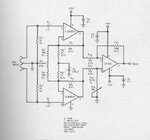jpglotzer
Newbie level 5
Hi,
I'm building this circuit. I get what some of it does, but I'm trying to fully understand the exact purpose of EVERY component, and why that exact size capacitor or resistor was used.
ece5030 plethysmograph
I get that the 10uF with the 20kohm is a high pass filter. How do I calculate the cut off frequency, and why that frequency was chosen? I think the 100K and 1K resistors determine the gain right? If i'm correct, it's just a ratio, so the gain is 100...
I don't get what the 0.47uF capacitor in parallel with the 100K resistor does..and I don't know why that value was chosen.
And the variable resistor from 1 to ground.. if I just kept that as a 10kohm resistor.. what does that do?
Ok, i think that's pretty much it. I'm sorta struggling with this, I've found similar circuits in textbooks, but they're all slightly different, so it doesn't seem 100% relevant. Any help would be much appreciated! Thanks!
I'm building this circuit. I get what some of it does, but I'm trying to fully understand the exact purpose of EVERY component, and why that exact size capacitor or resistor was used.
ece5030 plethysmograph
I get that the 10uF with the 20kohm is a high pass filter. How do I calculate the cut off frequency, and why that frequency was chosen? I think the 100K and 1K resistors determine the gain right? If i'm correct, it's just a ratio, so the gain is 100...
I don't get what the 0.47uF capacitor in parallel with the 100K resistor does..and I don't know why that value was chosen.
And the variable resistor from 1 to ground.. if I just kept that as a 10kohm resistor.. what does that do?
Ok, i think that's pretty much it. I'm sorta struggling with this, I've found similar circuits in textbooks, but they're all slightly different, so it doesn't seem 100% relevant. Any help would be much appreciated! Thanks!
